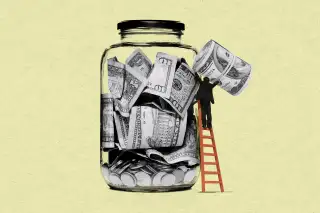The 401(k) Savings Rate Just Hit an All-Time High

Despite the stock market's rocky performance so far in 2022, retirement savers are remaining surprisingly resilient and stowing away a record percentage of their salaries.
The savings rate for people with 401(k) accounts reached a new high of 14% in the first quarter of 2022, according to a new report from Fidelity Investments. The 401(k) savings rate is the percentage of a person's salary that is contributed to a 401(k), including both employer and employee contributions.
While experts generally recommend a savings rate of 15% for individuals, the financial services firm underscored the significance of notching a record-high 14% rate overall amid a volatile market. During the same period last year, the savings rate was 13.5%. A decade ago, the rate was 12.2%.
“During periods of economic uncertainty, it's important for retirement savers to stay focused on their long-term savings goals and not make knee-jerk reactions to short-term market events,” Kevin Barry, Fidelity’s president of workplace investing, said in a statement.
Retirement account balances, however, have taken a beating lately as the S&P 500 has plummeted as much as 20% from its January high. In the first three months of 2022, the average 401(k) balance dropped 7% compared to the previous quarter, going from $130,700 to $121,700. That's down 2% from last year, Fidelity says.
So far, retirement savers are taking the right approach.
“Encouragingly, Fidelity's analysis found that the majority of retirement savers continued to demonstrate positive savings behavior, which will help keep them on track to reach their goals,” Barry added.
Namely, the contribution amounts not only remained steady but increased, and the vast majority of people with 401(k)s didn’t muck with their allocations in the face of a bear market. Fidelity data shows less than 6% tweaked their 401(k) allocations in the first quarter. And of those who did, 82% made only one change.
During the last bear market in 2020, Morningstar analyzed the behavior of more than 600,000 retirement savers. The firm found that those who kept contributing and refrained from making major changes to their investment plans were able to weather the market.
"Assuming you’re in a risk-appropriate, well-diversified portfolio, the best approach is probably to hang tight," wrote David Blanchett, Morningstar's former head of retirement research.
Much of the good news from the Fidelity report may be due to the prevalence of programs that automatically enroll workers and increase their contributions. Fidelity says 90% of people who are automatically signed up for their employer’s 401(k) end up staying enrolled. Likewise, 68% of contribution increases in the first quarter were due to automatic increase programs.
As markets continue to slide and retirement account balances tick down, sticking with long-term savings goals can be tough for retirement savers, but it can have a major payoff.
People who continuously contributed to their 401(k)s saw 124% growth in their account balance over a five-year period; 350% increase over 10 years; and 644% over 15 years. In other words, those who've been continuously saving for 15 years had an average account balance of $64,900 in 2007. According to Fidelity, that's now more than $480,000.
More from Money:
How Much Should You Save for Retirement?
Inflation Has Eroded 40% of Social Security's Buying Power Since 2000: Study
Want to Retire on Crypto? Fidelity Will Soon Allow Bitcoin in 401(k)s